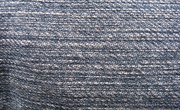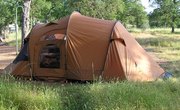
American pioneers used three types of covered wagons: the early basic farm wagon, the Conestoga and the Prairie Schooner. Although they differed in height, length and weight, the covered wagons that crossed the plains were constructed with basically the same materials.
Cloth
The bonnet or covering of the wagon was made of 10-oz. canvas, which is a heavy cotton duck material. In the 21st century, covered wagon makers use tight weave painters drop cloth. The canvas was covered with linseed oil to make it waterproof. Cotton draw strings sewn into the hems of the canvas at the front and back openings of the bonnet allowed the bonnet to be closed at night or for protection from the elements during the day.
Wood for Bows
Bows, the u-shaped wooden slats that supported the bonnet, were usually made from hickory, white oak or ash. The wagon worker cut five to eight strips of wood, depending on the type of covered wagon he was making, that measured 2-1/4 inch wide by 3/8 inch thick by 12 feet long and then soaked them in water for 24 hours. The slats were placed under a wagon wheel and the ends were slowly brought upward until they were about 30 inches apart. Then they were tied securely and allowed to dry for a couple of days before being used in the wagon.
Wood for Wagon
The Yankee bed, the basic bed of the wagon, and the sideboards above the bed were made of maple, hickory or oak. This part of the covered wagon consisted of long planks for the bottom and sideboards slightly longer than the bottom boards, which were bolted to the long side of the bottom boards. The seams were filled with pitch or tar to make them waterproof.
Other Uses for Wood
Hubs, spokes, and felly rims of wheels were made of oak. The front wheels of the covered wagon are smaller than the back ones, which make the wagon easier to manage.
The tongue, or falling tree, was an oak pole that extended out in front of the wagon that attached the horses, mules or oxen to the wagon. The length of the tongue depended on the number of animals needed to pull the load.
Oak doubletrees and singletrees were used for horses or mules only. Oak neck yokes were used for oxen.
Metal
Metal grommets were sewn into the canvas of the bonnet every 16 to 20 inches along the sides of the bonnet to tie it to the wagon. A light rope strung through the grommets was secured by metal hooks in the sideboards, which anchored the bonnet in place.
Hand-forged iron was used for many parts of the wagon, such as clouts, lynch pins and thimble skein axles. Iron also was used to strengthen wood in stress areas such as for braces to support the Yankee bed at the corners and in the hubs of the wheels. Iron tires were fitted around the wooden rim of the wheels to support the wood and to take wear and tear.
References
Writer Bio
Tonya Yirka is an Indiana-based writer who has focused on writing for online publications since 2009. She contributes many articles about Chinese culture and traditions to various websites. Yirka, a retired teacher, has a Bachelor of Science in education from Indiana University and attended classes toward a Master of Science in educational studies.



